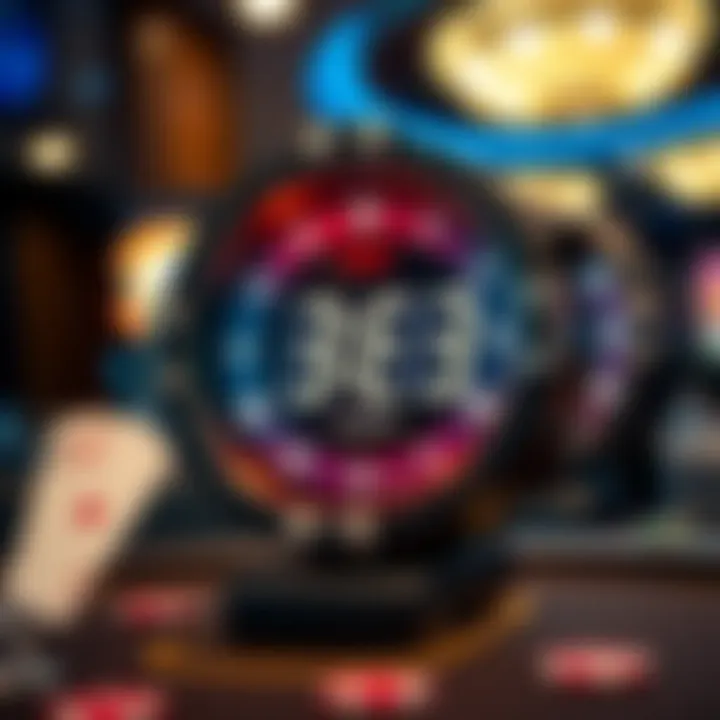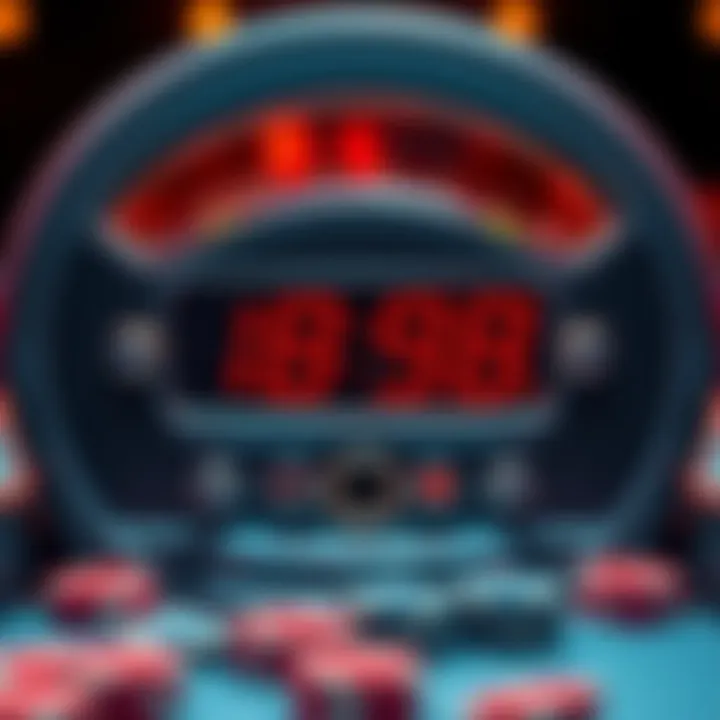Essential Insights on Poker Tournament Clocks


Intro
In the world of poker, time is not just a concept; it is a crucial element that can dictate the pace and flow of a tournament. The significance of a well-timed game is often overlooked, yet it can mean the difference between a satisfying experience and a chaotic nightmare. Without proper time management, even the most skilled players can find themselves tangled in a web of confusion.
Here's where poker tournament clocks come into play. They are the unsung heroes of organized play, ensuring that everything runs smoothly and effectively. This article is set to take you on a journey through the fundamental features of these devices, the various models available, and how they shape player strategies. Remember, whether you're running a local game night or managing large-scale tournaments, understanding the role of these clocks can enhance the overall experience.
We'll delve into the criteria that should guide your choice when selecting a tournament clock and explore how these tools influence structures and strategies over time. So sit tight as we unwrap the nuances and considerations involved in setting up the best poker tournament clocks that money can buy, no matter if you're a poker enthusiast or a seasoned professional.
Intro to Poker Tournament Clocks
In the fast-paced world of poker, time can often be the difference between victory and defeat. Understanding the fundamental role that poker tournament clocks play is crucial not only for players but also for organizers and enthusiasts alike. These clocks serve more than just the aesthetic purpose of keeping time; they are instrumental in managing tournament structure, maintaining player engagement, and ensuring fairness throughout the event.
When we talk about poker tournament clocks, we delve into their multiple functions—regulating the blinds, managing the overall pace, and providing essential countdowns that keep everyone on their toes. Tournaments, whether in a professional setting or among friends, rely heavily on clocks for their smooth operation, highlighting their significance in creating a balanced playing field. A well-managed tournament with an efficient clock can enhance player focus, leading to a more enjoyable and competitive experience.
Definition and Purpose
Poker tournament clocks can be succinctly defined as timing devices used to oversee the duration of poker rounds and manage blind structures. The purpose of these clocks transcends mere timekeeping; they facilitate the organization of play while adhering to established tournament rules.
For example, a typical poker tournament clock will display the time remaining in a round as well as the current blind levels. As the rounds progress, the clock signals players not only when to act but also adds an element of strategy. Players must adjust their tactics based on the duration left on the clock and how the increasing blinds affect their chip stacks.
Historical Context
The use of tournament clocks has evolved significantly since the early days of poker. Originally, informal games relied on the consensus of players to regulate time, which often led to disagreements and confusion. Over time, as poker became more formalized and gained prominence in casinos and competitive settings, the need for a standardized system emerged.
The introduction of digital clocks in the late 20th century marked a turning point. Initially, these clocks were basic, primarily used to announce the end of each round. However, as technology advanced, so did their capabilities. Modern poker tournament clocks now come equipped with features such as customizable blind structures, sound alerts, and even integration with online platforms for remote tournaments. This transformation reflects the growth of poker from a leisure activity to a complex sport that values timing as much as skill.
Importance of a Good Tournament Clock
When it comes to orchestrating a successful poker tournament, the clock is more than just a timekeeper; it serves as the backbone of the game. A good tournament clock not only regulates the flow of play but also significantly elevates the overall experience for players and organizers alike.
Tournament Organization
Effective tournament organization hinges on precision and clarity. In the fast-paced world of poker, mismanagement of time can lead to chaos. A reliable clock ensures that each level is adhered to with meticulous timing. Players are aware of when blinds will increase, enhancing the strategy involved in their gameplay. Plus, when the clock is visible and clear, it minimizes confusion. For instance, an overwhelming number of players often find themselves glancing at a standard wall clock that’s too far away to read. In a contrast to that, using a digital tournament clock prominently displayed provides immediate visibility, making the tournament much smoother.
The right clock includes programmable settings for the structure of the tournament, which allows for various tournament styles. Whether it’s a turbo event or a deep stack, having a customizable clock eliminates the need for last-minute adjustments that could derail the entire tournament flow.
Moreover, an organized tournament clock can help mitigate disputes among players. If timing issues arise, a good clock with a straightforward interface allows organizers to address any concerns with transparency. Organizers can focus more on the gameplay rather than worrying about timing uncertainties.
Player Focus and Fair Play
Player focus is critical in poker, and the tournament clock plays a vital role in maintaining that focus. With clear time indicators, players can strategize without the distraction of uncertain timing. When players know how much time they have left in a round, they’re better equipped to make more strategic decisions — not just move all-in on a whim.
Additionally, fairness is a cornerstone of competitive play. When all players have the same information regarding time, it levels the playing field. Good clocks can often feature sounds to alert players of a nearing time limit, ensuring no one is caught off guard. This is particularly important when you consider that many tournaments take place over several hours. Players can easily lose track of the overall pace of the game, and an unobtrusive beep can serve as a gentle reminder to get back to the game, preserving the spirit of competition.
Moreover, utilizing a high-quality tournament clock fosters trust among players. When participants experience a well-organized tournament with reliable timing, they feel assured that there are no favors or biases being shown. In a setting where emotions can run high, having this consistent capability is invaluable.
"A well-timed game is a fair game. Good clocks are not just tools; they’re the unsung heroes of tournament success."
Ultimately, investing in a good tournament clock is not merely a matter of aesthetics or convenience. It’s about crafting an environment where both players and organizers can thrive, free from the distractions that poor time management can foster.
Key Features to Consider
When diving into the world of tournament clocks, it's crucial to understand what sets apart a good clock from a mediocre one. These clocks aren’t just about counting down minutes; they can significantly shape the flow and fairness of a tournament.
Display and Readability
One of the foremost factors to look at is the display and readability of the clock. Imagine being in a heated tournament, the tension thick enough to cut with a knife, and squinting at a small, poorly illuminated clock. That's a recipe for disaster! Players should have a clear view of the time left, regardless of where they sit. Tournament organizers should aim for a digital display that boasts high contrast and large fonts, ensuring everyone can read it without straining their eyes. Additionally, backlighting is a crucial feature during dimly lit evenings where every bit of visibility matters.
- Tips for Choosing Display Options:
- Look for at least a 12-inch digital display for optimal visibility.
- Ensure the clock has adjustable brightness settings; this can be a game-changer.
Sound Options
While some might consider sound options to be merely an accessory, they actually play a pivotal role in tournament dynamics. A well-designed poker clock should provide audible cues. For instance, whether a soft beep or a more pronounced chime, these alerts can keep players on their toes. When the clock is about to expire, that notification can make all the difference between a well-planned move or a hasty error.
- Sound Features to Consider:
- Adjustable volume controls allow flexibility for different environments.
- A variety of sound options can cater to personal or venue preferences.
"The right sound not only keeps players alert but also adds a layer of engagement during play."


Functionality and Ease of Use
Last but certainly not least, the functionality and ease of use of a tournament clock can't be overstated. Complicated setups can lead to delays and frustration, which is about as welcome as a rainstorm at a picnic. Players and organizers should be able to adjust settings quickly and intuitively, whether it’s to change the blinds or extend the time left in a round.
Here’s a few features that enhance functionality:
- Straightforward Interface: A user-friendly touchscreen or physical buttons that don't require reading a manual before each tournament is essential.
- Preset Timers: Many clocks allow you to save specific tournament structures, which can save time at the start of events.
Types of Tournament Clocks
When it comes to organizing poker tournaments, the choice of tournament clocks is not merely a matter of preference. The right type of clock can make all the difference in how a tournament flows and how players engage with the game. Understanding the various types of tournament clocks available provides valuable insight for organizers, enhancing the overall structure and experience of the poker event.
Digital vs. Analog Clocks
Digital clocks have become the go-to choice for most modern poker tournaments, primarily due to their precision and ease of operation. With a clear digital display, players can easily track the remaining time in a blind level or the total time for their decisions. These clocks often come equipped with customizable features that suit various tournament formats. For instance, tournament directors can easily adjust blind levels, time limits, and other parameters to reflect the specific needs of their game, all at the touch of a button.
On the flip side, analog clocks offer a more traditional feel that some poker enthusiasts appreciate. The visuals of moving hands can create a nostalgic atmosphere reminiscent of classic poker games. However, they typically lack the advanced features found in digital versions. Adjustments can be more cumbersome, often requiring manual intervention. Hence, while analog clocks may appeal to purists, they can lack the versatility that digital clocks provide in a fast-paced environment.
"Digital clocks are like having a personal assistant who never sleeps, while analog ones feel like looking at the world through a rearview mirror."
Smart Tournament Clocks
The advent of technology has led to the emergence of smart tournament clocks, which combine the best features of digital clocks with cutting-edge technology. These devices can synchronize with online platforms, offering real-time updates to remote players. With features like app integration, organizers can manage tournament settings from their smartphones or tablets without being tethered to a physical clock. This is particularly handy for larger tournaments where managing multiple tables can be a logistical nightmare.
Smart clocks can also include advanced statistical tracking, providing insights into player behavior and table dynamics. The ability to observe how players scramble for time during high-stakes moments can offer valuable feedback for future tournament layouts. However, adopting these devices also raises considerations about reliability and potential technical issues. Unlike traditional options, smart clocks rely on consistent power and connections to function properly.
In short, choosing between digital, analog, or smart clocks depends heavily on the specific context of the tournament. Factors like the number of players, stakes involved, and overall ambiance play crucial roles in determining which type fits best. Organizers must weigh these characteristics to ensure a seamless tournament experience.
Evaluating Popular Tournament Clocks
Evaluating popular tournament clocks is an essential step in ensuring a seamless and engaging gaming experience for both players and organizers. The correct timing device serves as the heartbeat of any poker event, regulating the flow of the game and influencing strategies at every hand. With numerous options flooding the market, diving deep into the specifics of each clock is not just beneficial; it’s necessary for making informed decisions.
A thorough evaluation allows tournament hosts to weigh the features that best suit their needs, considering factors such as ease of setup, functionality, and user reviews. The right clock can enhance the pace of play and reduce downtime, keeping the atmosphere electric. This meaningful choice directly impacts how well a tournament runs, which can be the difference between a stellar event and a mediocre one. Currently, some brands are recognized for their innovation and reliability, making them stand out in the crowded marketplace.
Top Brands on the Market
Several brands have cultivated a reputation for quality when it comes to poker tournament clocks. Here’s a look at some leading names:
- ChronoPoker: Known for its advanced digital displays and user-friendly interfaces, ChronoPoker clocks are favorites in both casual and professional settings. Their clocks often feature customizable time settings to fit any tournament structure.
- TimerPro: TimerPro specializes in clocks that focus on clarity. With bright LED displays and intuitive controls, they’re a popular choice among casino managers. They also provide clocks with sound options which players appreciate during intense moments.
- Poker Timer: This brand is gaining traction thanks to their innovative smart clocks. They synchronize with online platforms, making them ideal for hybrid tournaments. Their focus is on integration, which allows for smooth transitions between live and virtual play.
- Big Time Clocks: Known for their durability, Big Time Clocks can withstand the rigors of daily tournament use. Their portable models are preferable for traveling event organizers.
Exploring these brands is more than just checking off a list; it’s about understanding how they align with the specific needs of your tournament setup.
Comparative Analysis of Features
When evaluating tournament clocks, a comparative analysis of features can prove invaluable. Each model brings unique advantages, which can ultimately influence player satisfaction and game integrity. Here are key features to consider:
- Display and Readability: A great clock should offer clear visual displays. Digital displays often shine here, allowing players to see time remaining from a distance. Clocks with adjustable brightness settings can adapt to different ambient lighting environments.
- Functionality: Ease of use is crucial. Look for clocks that allow swift adjustments, especially during a tournament's progression. The ability to easily switch between different timing structures—whether it's standard, deep stack, or turbo—is a deciding factor.
- Sound Options: Some players thrive in silence while others find cues necessary when the pressure mounts. The best tournament clocks provide customizable sound alerts for crucial time intervals.
- Integration and Technology: Clock models that offer compatibility with poker management software aid in maintaining tournament integrity. Real-time updates on blind levels and player positions enhance the overall experience.
By considering these elements and comparing models, one can identify the perfect poker tournament clock tailored to their specific event needs.
Price vs. Quality
When diving into the world of poker tournament clocks, the relationship between price and quality often stands out as a pivotal factor influencing purchase decisions. Invest too little, and you might end up with a clock that can barely keep time, let alone cater to the specific needs of a poker tournament. On the flipside, outlaying too much for features that may never get utilized can leave one's budget in tatters. Hence, it becomes crucial to find that sweet spot where quality undoubtedly meets affordability.
Selecting a well-constructed tournament clock does not merely reflect an expenditure; it manifests an investment in the overall gaming experience. A higher price often correlates with more advanced features, durability, and ease of use, which are quite essential during intense matches. Gamblers, casino managers, and enthusiasts alike appreciate units that stand the test of time, both in terms of physical robustness and in functionality.
Notably, when considering clocks for tournament use, one must also reflect on customer feedback and reviews. It's not about the price tag alone. Rather, how well does it perform? Is it user-friendly? Does it enhance the gameplay experience? Factors like these can vastly overwrite initial cost savings if the unit fails to deliver in a real tournament setting.
Budget Options vs. Premium Choices
When weighing budget options against premium choices, it’s vital to recognize that there’s a great variety of products on the market. Budget clocks can serve well for friendly games at home or casual gatherings. Often priced below a hundred dollars, these clocks may come with basic countdown features and limited display capabilities. Users can expect some functionality that keeps the game running smoothly, but they might compromise on robustness.
On the other hand, premium choices generally provide a substantial increase in reliability and features, often priced upwards of several hundred dollars. These devices usually encompass advanced functionalities such as customizable settings, sound alerts, and even online software compatibility. They are designed to cater to both casual players and professional settings, ensuring that the demands of an official tournament atmosphere are met effectively.
- Budget options often include:
- Premium choices typically offer:
- Basic display technology
- Minimal timer functions
- Lower build quality
- Enhanced visibility with larger screens
- User-friendly interfaces
- Robust durability for frequent event usage
Long-term Value Considerations
When considering a poker tournament clock, long-term value is an aspect that can’t be overlooked. The key here is not just immediate cost but the overall return on investment over time. A cheap clock that breaks down in a few months necessitates recurrent replacements, which rapidly adds up.


Conversely, investing in a good quality clock can lead to great long-term savings and enhanced tournament management. Most premium clocks come with warranties and support, which can be difficult to find in budget models. Buying a clock with strong customer service backing could save significant hassle during urgent tournament preparations.
Moreover, features such as ease of use, compatibility with various tournament structures, and adaptability to different formats significantly contribute to a clock's long-term value. They not only alleviate stress for organizers but also enhance player satisfaction, ultimately leading to a more enjoyable gaming session.
Customizable Features
In the realm of poker tournaments, having a clock that caters to individual preferences and specific tournament needs can significantly enhance the overall experience. A tournament clock that allows for customizable features empowers organizers and players alike, reflecting the diversity and dynamics of poker itself. This flexibility can lead to smoother operations and improved player satisfaction.
User-defined Time Settings
Setting the right pacing for a tournament is crucial. User-defined time settings give tournament directors the ability to tailor the clock according to the specific format of the game. For example, in a fast-paced turbo tournament, players might benefit from shorter blind levels, while a deep stack tournament might require longer levels to encourage strategic play.
Moreover, custom time adjustments allow players to engage at a comfort level that suits them. This not only caters to experienced players who may prefer a rigorous pace but also accommodates novices needing a bit more time to mull over their decisions without feeling rushed.
"In poker, time can be as important as the cards you hold. Managing it well can change the course of the game."
Format and Style Preferences
Different games require different styles, and this extends to the clocks used in tournaments. Customization options for format and style preferences allow users to tweak the appearance and display of the clock itself. For instance, some players may prefer a digital clock with bright, clear numbers, while others may find an analog clock more visually appealing and easier to interpret at a glance.
Style preferences can also play into thematic tournaments, where aesthetics contribute to the ambiance. An eye-catching tournament clock can become part of the event’s branding, making it memorable for participants.
There might also be considerations for functioning in varied lighting conditions—like in a dark casino setting where a luminous display might be essential. Such customization choices not only gravitate towards personal taste but can improve the overall functionality and user experience during the tournament.
With the right customizable features, poker tournament clocks aren’t just tools; they become integral parts of the gaming environment, enhancing competition and contributing to the thrill of the game.
Integration with Online Platforms
In today’s digital age, the role of poker tournament clocks transcends the physical aspects of game management. Integration with online platforms has become crucial not only for enhancing player experience but also for streamlining the overall tournament process. This integration facilitates communication between various systems involved in running a successful poker event, from registration to real-time updates of player status.
When tournament organizers think about integration, they have to consider several key elements that can significantly impact the tournament's flow.
- Real-Time Updates: An essential feature of online integration is the ability to receive real-time information. This means that as players make their moves, the clock can adjust automatically, ensuring everyone is on the same page.
- Data Synchronization: Whether a player is at the table or participating remotely, having synchronized data is vital. This ensures that the clock reflects actual game time without delays.
- User Interface: A well-designed interface can make all the difference. The clock's layout should complement online platforms, making it easy for everyone—organizers and players—to understand what’s happening at a glance.
Integration may also allow for advanced features such as:
- Automatic time adjustments based on various game stages.
- Streamlined registration processes where players can check in and receive clock notifications in one place.
- Customization for different game types or specific tournament rules, making each event unique without manual recalibrations.
Software Compatibility
A significant consideration when selecting a tournament clock is its software compatibility with widely used poker management systems. Many of these systems have specific standards that clocks need to meet. For instance, integration with platforms like Bravo Poker or PokerTracker can enhance functionality and accuracy.
It’s essential for organizers to check that the clock can seamlessly work with their existing setup. Incompatible software can lead to headaches, such as missed updates or delays.
- APIs and SDKs: Some manufacturers offer an API or SDK that allows for custom integrations. This can be incredibly beneficial for event organizers looking for tailored solutions.
- Firmware Updates: Look for clocks that provide regular updates. Software bugs can often be fixed, and features improved—having a clock that is regularly maintained is more beneficial in the long run.
Enhancing Remote Tournaments
As the online poker scene continues to grow, remote tournaments have become increasingly popular. Tournament clocks that integrate seamlessly with online platforms can help maintain a competitive edge in these environments.
- Time Management: For remote tournaments, clear and consistent time management is crucial. Players must feel the pressure of the clock just as they would in person. Integration ensures that time is tracked accurately, regardless of whether players are online or sitting at a physical table.
- Reduce Lag Time: Lags in clock updates can lead to game disputes. A well-integrated clock minimizes latency, ensuring players can focus on strategy rather than worrying about whether the clock is keeping up with the game.
- Player Engagement: Integrated clocks can be set to deliver alerts, prompts, or reminders to players. This can enhance player engagement and maintain their focus, providing an almost immersive tournament experience.
The importance of robust integration in online platforms cannot be understated. It is what transforms an ordinary poker event into a highly efficient tournament experience. In summary, understanding and implementing effective integration strategies can significantly influence player satisfaction and tournament success.
"In the realm of digital poker, synchronization is king; you can’t afford to lose track of time."
For further information about online poker and tournaments, check out the resources available at Wikipedia and Reddit.
By focusing on these aspects of integration, both new and seasoned poker tournament organizers can find their footing in the evolving landscape of poker management.
User Experiences and Reviews
User experiences and reviews play a crucial role in the evaluation of poker tournament clocks. They offer insights into practical performance under real tournament conditions, going beyond the specs and features promised by manufacturers. When it comes to choosing a clock, understanding how it functions in the heat of the moment can make all the difference for both players and organizers.
Understanding the Importance
User reviews provide a first-hand account of features like clock readability, ease of setup, and overall robustness. These insights can illuminate aspects that marketing materials often gloss over. For example, a high-quality display might be promoted, but user feedback can reveal whether it's practical under different lighting or distances—details that become apparent only in live situations.
Moreover, reviews often touch on the customer service experience associated with a product, which can be a deciding factor. A poker tournament clock may have all the bells and whistles, but if it doesn't come with solid support when something goes awry, that's a significant drawback.
Gathering User Feedback
In the realm of poker, the voice of the user is essential. Gathering user feedback can be approached in several ways.


- Online Forums and Communities:
Websites like Reddit and poker-specific forums can provide a treasure trove of user experiences. Players share stories about their tournament experiences—successes and failures tied to the clocks used. - Social Media Reviews:
Platforms like Facebook often house discussion groups dedicated to tournament organization. Here, members may share their opinions about various brands and models, including ratings that can help potential buyers make sound decisions. - Surveys at Events:
Organizers can conduct brief surveys post-tournament to gather immediate feedback from participants on the clocks used, providing a real-time sense of satisfaction.
Case Studies from Event Organizers
Examining case studies from event organizers can offer a deeper understanding of how specific clocks performed during actual tournaments. For example, in the 2022 annual World Poker Festival, organizers decided to swap their usual clock for a new digital model. The feedback they received was illuminating:
- Enhanced Time Management: Players appreciated the clear interface, allowing them to stay focused on their strategies without worrying about time constraints.
- Improved Player Satisfaction: Many participants reported feeling more relaxed under pressure, indicating a more seamless experience due to the reliable timing.
Another event, the North American Poker Championship, recently showcased a smart clock that integrated with their online platform seamlessly. This clock not only tracked time but also displayed player countdowns and blind levels on screens visible to everyone at the table—a feature that was praised universally. The event’s organizer noted:
"Having a clock that players can see without breaking their concentration was a game changer. It kept the energy high and ensured everyone was on the same page."
In both cases, the lessons drawn showed that choosing the right poker tournament clock can significantly impact the overall game dynamics, player satisfaction, and even the outcome of tournaments. This collective feedback is not mere chatter; it's vital data that can guide future purchases and practices in tournament management.
The Impact of Timing on Tournament Dynamics
Timing in poker tournaments is more than just keeping track of the clock; it dictates the rhythm and flow of the game. A well-configured tournament clock influences not only the structure but also player decisions and overall tournament satisfaction. With each tick of the second hand or digital count down, strategic layers unfold that determine who will rise to the top. Understanding the impact of timing can enhance both management and experience for players and organizers alike.
Adjusting Strategies Based on Clock Settings
Every poker player knows the saying, "time is money." In tournaments, this rings truer than ever. The clock doesn't merely mark the end or beginning of rounds; it often prompts players to rethink their strategies in real-time. For instance, when blinds increase quickly, players might adopt a more aggressive style, feeling the pressure to accumulate chips lest they be blinded out.
Conversely, during longer levels, patience becomes essential. Players may hunker down, waiting for optimal hands rather than chasing every opportunity. This duality in strategy is a direct result of how the tournament clock is set and structured.
- Short Time Intervals: In tournaments where blinds escalate rapidly, like turbo events, players can’t afford to play too conservatively. They might adopt a riskier approach, often leading to spectacular errors or magnificent comebacks.
- Extended Rounds: Alternatively, tournaments with longer blind levels naturally set a slower pace, where strategic planning and hand selection take precedence. Players find themselves willing to fold more often, banking on not just their cards but also the waiting game.
Thus, the settings of the tournament clock act as a catalyst for player behavior and tactical adjustments that could mean the difference between triumph and defeat.
Managing Player Behavior
The influence of timing cannot be understated—it shapes how players interact at the table. Tournament clocks, when set correctly, can help manage the psychology of gameplay. When players see a clock ticking down, a sense of urgency can often lead to rash decisions. This phenomenon, sometimes referred to as the “pressure cooker effect,” can foster an environment where mistakes are made due to last-minute panic or time constraints.
Proper clock management encourages better behavior and sportsmanship. Observing how players adapt to the clock’s count can offer insights into their mindset:
- Increased Aggression: With rapidly increasing blinds, some players may shuffle chips nervously as they become aware of their dwindling stack, pushing them to make impulsive bets or raises.
- Calm and Collected: On the other hand, a well-paced clock encourages players to engage in thoughtful play, resulting in a more enjoyable atmosphere for both amateur participants and seasoned pros.
Managing clock settings is not just a mechanical task. It’s an art form that promotes an environment of fairness and concentration.
In sum, tournament clocks profoundly influence timing dynamics during play. By adjusting strategies based on settings and observing behavior shifts, both players and organizers can create an engaging and competitive environment, ensuring that everyone has their fair share of time to play their game.
Future Developments in Poker Tournament Clocks
In the ever-evolving world of poker, tournament clocks are becoming increasingly vital, shaping how events are managed and experienced by players. As technology progresses, these devices are bound to undergo remarkable transformations. Understanding the nuances surrounding these potential advancements offers both organizers and players insight into how their strategies and experiences may shift.
Technological Advancements
With rapid strides in technology, the tools we use in poker tournaments are also set to evolve. Today's clocks focus on clarity and punctuality, but future developments may deepen that focus significantly. For instance, the integration of artificial intelligence could personalize tournament settings in real-time, optimizing play based on each player’s pace and style. This could lead to systems that can modify time allocations or adjust blind levels in response to gameplay dynamics, enhancing the overall experience.
Additionally, the use of mobile applications for clock management is dramatically rising. Instead of bulky physical devices, we might see sleek mobile solutions that allow organizers to control time settings at their fingertips. Imagine a scenario where a tournament director can effortlessly adjust the clock via their smartphone from any spot in the casino, maintaining smooth transitions and ensuring an engaging atmosphere for all players.
Another exciting area for advancement is the potential for blockchain technology in tournament clock management. This could guarantee transparency in timing and fairness, allowing players to trust that all decisions made regarding time allocations are verifiable and devoid of any tampering. Implementing such technology would not only foster trust but could also lead us to a safer gambling environment overall.
Predicted Trends in Tournament Management
As we look towards the imminent future, several trends are emerging on the horizon, poised to alter how tournaments operate and how players interact with their environments. One key trend is the move towards increased customization in tournament structures. Players crave personalized experiences, and clocks that allow for customizable settings tailored to various formats are likely to enhance player satisfaction and engagement.
There is also a growing trend in hybrid tournaments that incorporate both in-person and online elements. With many players preferring the comfort of their homes, clocks that seamlessly mesh physical and digital realms could become the industry standard, allowing remote players to participate, observe, or manage tournament dynamics without being physically present. This hybrid approach could broaden the reach of poker events, creating expansive networks of players united by advanced clock systems to keep everyone synchronized.
Furthermore, the focus on player retention is becoming paramount. Tournament organizers are keen on developing environments where participants don’t just play but are also entertained. Future clocks may incorporate features such as live statistics and player progress visualizations, captivating players throughout the event. Such innovations will change how tournaments are perceived, shifting from a simple game of chips to a more immersive experience.
As we can see, the future of poker tournament clocks promises unprecedented advancements and trends. Keeping a keen eye on these developments will not only give organizers a competitive edge but will also enrich players' experiences on the felt.
Closure
In wrapping up discussions on poker tournament clocks, it’s evident that the right timing can shape not only the flow of the game but also the experience of every participant involved. This article has illuminated the various facets that contribute to a clock’s effectiveness, from its display qualities to sound features and integration with technology. When considering a tournament clock, it’s crucial to reflect on how each aspect influences the overall organization and dynamics of the event.
Summarizing Key Insights
The insights provided in this article underscore the multifaceted nature of selecting a poker tournament clock. Here are the key takeaways:
- Importance of Features: Prioritizing attributes like readability, adjustability, and sound options can greatly enhance player focus.
- Impact on Game Flow: A well-functioning clock not only helps in maintaining pace, but it also fosters a fair competitive environment.
- Technology Trends: The advent of smart clocks that integrate with online platforms presents exciting opportunities for tournament organizers, making it easier to manage structures and adapt to player needs.
These points reflect how integral a good clock is for any poker tournament, ensuring that players remain engaged and that the game proceeds without hiccups.
Final Thoughts on Choosing a Tournament Clock
When it comes to selecting the right clock, one size does not fit all. Evaluating options based on the type of tournament, available budget, and specific requirements will lead to better outcomes. Some players may thrive with classic analog setups, while others might prefer the advanced capabilities of digital smart clocks. Understanding one's audience and the desired atmosphere of the tournament is vital.
Ultimately, investing time into the selection process will pay off with a smoother running event. Whether you're a seasoned casino manager or an aspiring host, choosing the optimal poker tournament clock can enhance the game’s integrity. A calibrated combination of technology and usability can set you apart, ensuring memorable experiences for all attendees.















